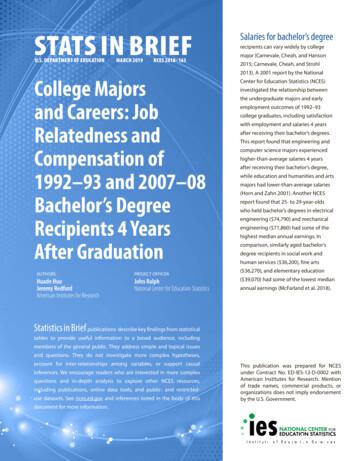Bachelor’s Program In Azerbaijani Language And Literature
Bachelor’s Program in Azerbaijani Language and LiteratureAs the name indicates, this program is based on the issues and topicsrelated to the Azerbaijani language and literature, as well as theinterconnection between the two. The program covers study of theAzerbaijani literature from the time of its emergence through the periods ofits development in chronological order. In this context, the life and works ofindividual writers and poets who lived in different periods are studied, theirliterary activities are explored, the national and global issues on which theyfocused are analyzed, the literary influences of one writer/poet on othersare determined, and their creative activities are systemized in line with thehistorical period they lived.Central to the coursework is the study of selected pieces of literary work bythe students and discussions about these works. The students are alsooffered a variety of elective courses.The “World Literature” part of the program has been designed taking intoaccount historical periods and geographical locations: the literature ofAncient and Medieval times, Near East, Far East, and Europe is studied;beginning with the 19th century, works from European, American, Russian,Near Eastern, and Far Eastern literatures are studied and analyzed in acomparative framework. The program also covers issues related withliterary critics.The Language part of the program focuses mainly on the extensive studyof the grammatical structures of the modern Azerbaijani language.Linguistic matters, the history of the literary language, and teachingmethods are also covered on a comparative basis.Elective courses help students to grasp various aspects of both languageand literature more deeply, obtain necessary research skills, and developcritical thinking.CodeCoursesCreditsUniversity Requirements21General Education Requirements*21
Major Requirements84Required Languagecourses21AZLL 106Modern AzerbaijaniLanguage - 16AZLL 108Modern AzerbaijaniLanguage - 26AZLL 206Modern AzerbaijaniLanguage - 36LING 216Fundamentals ofLinguistics6AZLL 306History of the AzerbaijaniLiterary Language6EDU 408Teaching Methods of theAzerbaijani Language6TURK 305Comparative Grammar of 6Turkic LanguagesRequired Literaturecourses36AZLL 107History of AzerbaijaniLiterature - 16AZLL 109History of AzerbaijaniLiterature - 26AZLL 207History of AzerbaijaniLiterature - 36AZLL 208History of AzerbaijaniLiterature - 46AZLL 307History of AzerbaijaniLiterature - 56
LIT 305World Literature - 16AZLL 308World Literature - 26LIT 405World Literature - 36AZLL 416Fundamentals of LiteraryCritics6AZLL 488The Environment ofEastern Languages andAzerbaijani Literature6EDU 409Teaching Methods ofAzerbaijani Literature6AZLL 497Creative Writing6Elective Language courses 15LING 493Comparative HistoricalLinguistics6LING 217History of AzerbaijaniLinguistics6TURK 201Introduction to Turkology6LING 614Linguistic Typology6LING 491Phonology6LING 428Ethno-linguistics6LING 426Structural Linguistics6LING 505Applied Linguistics6LING 427Psycho-linguistics6LING 421Socio-linguistics6LING 511Linguistic Methods6
AZLL 512Azerbaijani Dialectology6AZLL 513Onomastics6AZLL 514Textual Criticism6AZLL 603Historical Dialectology6AZLL 515Historical AzerbaijaniGrammar6Elective Literature courses 12LIT 215Ancient Eastern Literature 6LIT 216Literature of the AntiquePeriod6LIT 217Medieval EasternLiterature6TURK 102Literature of TurkicPeoples6LIT 310Medieval PersianLiterature6LIT 311Literature of Far EasternPeoples (China, Japan,Korea, and others)6LIT 312Indian Literature6AZLL 518Medieval AzerbaijaniLiterature6AZLL 215Azerbaijani “Divan”Literature6AZLL 520“Ashiq” Literature6AZLL 522Study of “Dede Qorqud”6AZLL 524Study of “Koroglu”6
AZLL 456Azerbaijani dramaturgy6AZLL 46620th-Century AzerbaijaniProse6AZLL 46820th-century AzerbaijaniPoetry6AZLL 470Literature of SouthAzerbaijan6AZLL 116Azerbaijani Child Literature 6LIT 410Western EuropeanLiterature during MiddleAges and RenaissanceLIT 41117th-18th-Century Western 6European LiteratureLIT 41219th-20th-Century WorldLiterature6LIT 413History of RussianLiterature6LIT 505Modern Literary Process6LIT 506Poetry6LIT 507Literary Critique (Historyand Theory)6LIT 508Literature and Aesthetics6LIT 516Theory of Literature6LIT 517Poetry and Philosophy6LIT 526Immigrant Literature6LIT 527History and Theory ofTranslation66
(other elective coursesmay also be offered)OpenElectivesTOTAL12Elective 16Elective 26264* Note: For the Azerbaijani Language and Literature Bachelor’s program,“Azerbaijani Language” and “Azerbaijani Literature” courses are notincluded in the General Education Requirements (GER). Unlike otherBachelor’s programs, GER in this program counts for 15 credits (instead of21 credits).
* Note: For the Azerbaijani Language and Literature Bachelor’s program, “Azerbaijani Language” and “Azerbaijani Literature” courses are not included in the General Education Requirements (GER). Unlike other Bachelor’s programs, GER in th
Bachelor of Science 2020/2021 www.usm.my SCHOOL OF PHARMACEUTICAL SCIENCES Bachelor of Pharmacy COMMUNICATIONS Bachelor of COMMUNICATIONS SCHOOL OF MANAGEMENT Bachelor of ACCOUNTING Bachelor of MANAGEMENT BACHELOR OF APPLIED SCIENCE SCHOOL OF PURE SCIENCES (PHYSICS, BIOLOGY, CHEMISTRY AND MATHEMATICS) BACHELOR OF SCIENCE SCHOOL OF MECHANICAL .
Telugu Tedim Chin Tamil Taiwanese Syriac Swahili Spanish Southern Kurdish South Azerbaijani Sorani Kurdish Somali Slovene Slovak Shanghainese S'gaw Karen Serbian Samoan Romanian Rohingya Pwo Eastern Karen Punjabi Pulaar Pukapukan Portuguese Pitjantjatjara Persian Pashto Oromo North Azerbaijani Nigerian Pidgin NZ Sign Language Nepali Montenegrin .
Turkic language group (which includes Turkish and Turkmen), the Azerbaijani language has a literary history dating back to the end of the thirteenth century. The language was written using the Arabic alphabet until 1929, whe
2. Bachelor of Engineering Technology (Hons.) in Business Management U15 3. Bachelor of Engineering Technology (Hons.) in Manufacturing Systems U17 4. Bachelor of Engineering Technology (Honours) in Railway System U21 5. Bachelor of Engineering Technology (Hons.) in Precision Engineering U22 6.
Bachelor of Science (Human Geography, Environment and Heritage Management) 6 S1 & S2 16,200 97,200 Bachelor of Science Education 8 S1 13,824 110,592 Bachelor of Social Change and Advocacy* 6 S1 13,296 79,776 Bachelor of Social Science 6 S1 & S2 13,296 79,776 Bachelor of Social Work
degree completers in 1992-93 and 1.6 million in 2007-08. This brief is based on first-time bachelor's degree recipients only. 2 2 Because estimates are for first-time bachelor's degree recipients only, the 11.3 percent of 1992-93 bachelor's degree recipients and 7.0 percent of 2007-08 bachelor's degree recipients who had earned
Independent Personal Pronouns Personal Pronouns in Hebrew Person, Gender, Number Singular Person, Gender, Number Plural 3ms (he, it) א ִוה 3mp (they) Sֵה ,הַָּ֫ ֵה 3fs (she, it) א O ה 3fp (they) Uֵה , הַָּ֫ ֵה 2ms (you) הָּ תַא2mp (you all) Sֶּ תַא 2fs (you) ְ תַא 2fp (you
of tank wall, which would be required by each design method for this example tank. The API 650 method is a working stress method, so the coefficient shown in the figure includes a factor of 2.0 for the purposes of comparing it with the NZSEE ultimate limit state approach. For this example, the 1986 NZSEE method gave a significantly larger impulsive mode seismic coefficient and wall thickness .























